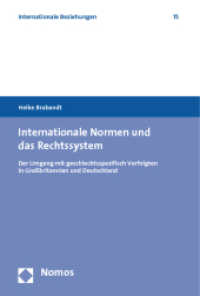- ホーム
- > 洋書
- > ドイツ書
- > Mathematics, Sciences & Technology
- > Earth Science
Full Description
mso-bidi-theme-font: minor-latin;">Together, the two volumes provide a holistic view, with Volume I offering the problem analysis and Volume II presenting practical solutions, making them ideal resources for understanding both the theoretical and applied aspects of managing toxic metals in environmental systems.








